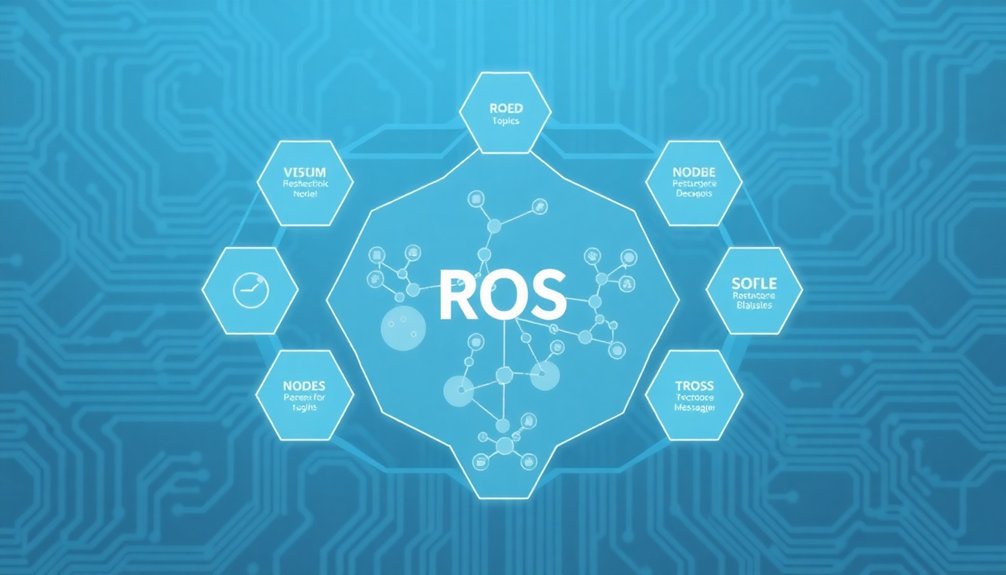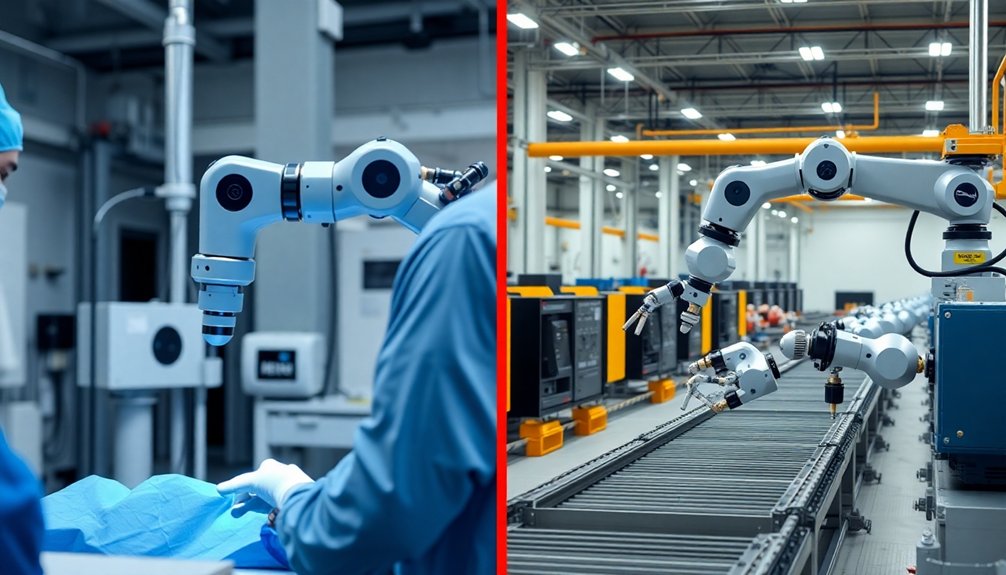Robot Operating Systems (ROS) are your digital backstage manager for intelligent machines. They transform robots from rigid, preprogrammed tools into adaptive, learning systems that can navigate complex environments. Think of ROS as the brain’s operating system – enabling robots to communicate, share data, and make split-second decisions across industries like healthcare, manufacturing, and autonomous vehicles. Want to peek behind the robotic curtain?
Understanding Robot Operating System: Core Architecture and Design

The digital nervous system of modern robotics, ROS isn’t your grandpa’s operating system. It’s a game-changing framework that lets roboticists build smart machines like digital Lego.
With its modular design, ROS breaks down complex robotic systems into bite-sized, swappable nodes that communicate through a publish-subscribe model. Want sensor data acquisition? Boom. Need movement control? Done. The architecture’s scalability and flexibility mean you can mix and match functionalities faster than a DJ remixes tracks.
Think of the ROS ecosystem as a robotic Swiss Army knife. Each package is a specialized tool that solves specific challenges, from navigation to perception. Digital twin technology allows for advanced virtual training of robotic systems, enhancing the potential of ROS-based intelligent machines.
It’s not just software; it’s a collaborative playground where developers worldwide contribute, test, and improve robotic intelligence. Who said robots can’t be adaptable?
Technical Foundations: How ROS Enables Robotic Communication
When diving into the robotic communication landscape, ROS emerges as a brilliant maestro conducting an intricate symphony of data exchange.
It’s like a backstage manager for robots, ensuring every component talks smoothly and efficiently. Through its publish-subscribe model, ROS facilitates robotic communication by letting nodes share messages like gossipy colleagues at a tech conference.
Each node becomes a specialized worker, performing unique tasks while seamlessly connecting with others. Services provide instant communication channels, enabling rapid decision-making that would make traditional systems look like slow-motion replays.
Want real-time processing? ROS has your back. Its modular design means you can swap components faster than changing smartphone apps.
The result? A robotic ecosystem where communication isn’t just possible—it’s elegant, flexible, and downright intelligent. Sensor fusion techniques allow ROS to integrate multiple data streams, enhancing robotic perception and adaptive capabilities across complex environments.
Industry Applications: ROS Transforming Sectors From Healthcare to Manufacturing

Imagine a world where robots aren’t just sci-fi fantasies, but practical problem-solvers transforming entire industries. ROS isn’t just code—it’s the secret sauce making this revolution happen.
In healthcare, surgical robots now perform delicate procedures with superhuman precision, reducing human error. Autonomous vehicles cruise highways using ROS-powered sensor networks that process environmental data faster than you can blink.
Robotic precision meets human care: surgical innovation and autonomous intelligence reshaping our technological landscape.
Manufacturing floors hum with industrial robots executing complex tasks with robotic efficiency, slashing operational costs and boosting productivity.
Ever wondered how drones navigate treacherous search and rescue missions? ROS. Want to see agricultural monitoring that’s smarter than traditional methods? ROS again.
Its modular architecture means robotics applications can be developed quickly, adapting to whatever wild challenge comes next. Humanoid robot designs are pushing the boundaries of what’s possible in robotic perception and movement. The future isn’t just automated—it’s intelligently connected.
Solving Complex Challenges: ROS Development Strategies
You’re not just building robots; you’re architecting digital nervous systems that can think on their feet—or wheels, or wings.
ROS’s modular approach lets you snap together complex robotic solutions like high-tech LEGO, turning once-impossible challenges into plug-and-play innovations.
Whether you’re creating surgical robots that can dance through human tissue or autonomous vehicles that navigate chaotic city streets, your development strategy isn’t about writing code—it’s about designing intelligence that adapts, learns, and solves problems in real time.
Modular Software Architecture
Because robotics development used to feel like wrestling an octopus in a hurricane, ROS’s modular software architecture swoops in like a digital Swiss Army knife.
You’ll love how this approach transforms complex systems into bite-sized, manageable chunks. By breaking down robotics challenges into specialized nodes that chat seamlessly, ROS lets you build smarter machines without losing your mind.
Think of it as Lego for robots: each component snaps together with minimal fuss.
Want rapid prototyping? ROS’s tools and libraries make it a breeze. Seamless integration isn’t just a promise—it’s a reality. You can mix hardware, swap out software packages, and debug with built-in visualization tools that make your workflow smoother than a robot’s aluminum skin.
Who said cutting-edge tech has to be complicated? Narrow AI principles provide the foundational framework for ROS’s intelligent modular design, enabling more efficient robotic software development.
Real-Time Problem Solving
From snapping together modular components, ROS graduates to something even more powerful: real-time problem-solving that makes traditional robotics engineering look like a toddler’s finger painting. You’re not just building robots; you’re creating intelligent systems that respond faster than a cat’s reflexes. Neural networks transform these robotic systems from reactive machines into predictive, adaptive intelligences capable of sophisticated decision-making.
| Feature | Capability | Impact |
|---|---|---|
| Real-Time Processing | Instant Response | Lightning-Fast Decisions |
| Efficient Communication | Node Interconnectivity | Seamless Data Exchange |
| ROS 2 | Enhanced Performance | Critical Application Support |
| Simulation Environments | Risk-Free Testing | Iterative Development |
| Modular Architecture | Flexible Components | Adaptive Robotic Solutions |
ROS 2’s deterministic communication turns robotic applications from clunky machines into precision instruments. By leveraging simulation environments like Gazebo, you’re not just designing robots—you’re choreographing digital dance performances where every movement is calculated, every response instantaneous. Who said engineering can’t be art?
Scalable Robotic Development
When robotic complexity meets scalable design, ROS transforms from a mere framework into a digital Swiss Army knife for problem-solvers. ROS enables developers to tackle complex tasks by mixing and matching functionalities like digital Lego blocks.
You’ll leverage sensor data integration and modular architectures that adapt faster than a chameleon changes colors. Reinforcement learning techniques enhance robots’ ability to learn through continuous adaptation and experience-driven skill development.
Want to build advanced robotic systems without reinventing every wheel? The ROS community’s got your back. Its publish-subscribe communication model lets nodes chat efficiently, while tools like `rosdep` and `rosbag` streamline dependency management and performance optimization.
Reinforcement learning integration means your robots can learn and improve in real-time, turning static machines into adaptive problem-solving machines.
Scalable robotic development isn’t just possible—it’s now your playground.
Emerging Trends: ROS in Artificial Intelligence and Internet of Things
As artificial intelligence and the Internet of Things continue to blur technological boundaries, Robot Operating Systems (ROS) are emerging as the secret sauce that transforms clunky machines into smart, collaborative networks.
ROS isn’t just middleware; it’s the neural network connecting AI and IoT devices, enabling seamless communication that makes advanced robotic systems feel almost magical.
Machine learning algorithms now let robots learn and adapt in real-time, turning them from rigid automatons into flexible problem-solvers.
Want to see the future? Imagine robots that collaborate effortlessly, sharing data and making split-second decisions across complex environments.
From smart logistics to healthcare robotics, ROS is quietly revolutionizing how machines think, communicate, and interact.
It’s not sci-fi anymore—it’s happening right now, and the possibilities are mind-blowing.
Neuromorphic computing is revolutionizing machine thinking by enabling robots to learn and adapt more efficiently, drawing inspiration from biological neural networks and reducing power consumption.
Future Perspectives: ROS Evolution and Global Impact

The magical world of robotics isn’t just expanding—it’s exploding with potential, and Robot Operating Systems are leading the charge into uncharted technological territories. Continuous learning and adaptation are becoming critical as ROS technologies transform workforce capabilities across industries.
ROS has become a versatile tool transforming the robotics field, rapidly evolving from a simple framework to an extensive overview of technological innovation. You’ll see its impact everywhere—from autonomous vehicles traversing complex city streets to medical robots performing delicate surgeries.
The vibrant community driving ROS forward isn’t just coding; they’re reimagining how machines interact with our world. As industries embrace this technology, ROS is breaking down barriers between human imagination and robotic execution.
It’s not just software—it’s a revolution in how we conceive intelligent machines. Will you be part of this technological wave, or watch from the sidelines?
People Also Ask About Robots
What Is ROS Used for in Robotics?
You’ll use ROS to develop, control, and coordinate robotic systems by enabling communication between robot components, processing sensor data, planning navigation, and managing complex tasks across multiple domains efficiently.
What Is the Difference Between OS and ROS?
You’d think all operating systems are created equal, right? Wrong! While an OS manages general computing, ROS is a specialized middleware that orchestrates robotic systems, enabling seamless communication, sensor integration, and complex algorithmic interactions.
Does NASA Use ROS?
Yes, NASA’s definitely using ROS across multiple robotic projects! You’ll find it powering Mars rover missions, humanoid robots like Robonaut, and autonomous aerial vehicles, enabling advanced exploration and research technologies.
Which Operating System Is Best for ROS?
You’ll find Ubuntu the top choice for ROS, particularly versions 20.04 and 22.04. It’s widely supported, offers robust compatibility with ROS distributions, and provides the most extensive development environment for your robotic projects.
Why This Matters in Robotics
ROS isn’t just software—it’s the nervous system of our robotic future. Like a digital puppeteer, it’ll pull the strings of machines transforming everything from surgery rooms to factory floors. You’re witnessing the dawn of intelligent automation, where robots won’t just follow commands, but think, adapt, and collaborate. Buckle up: the robotic revolution isn’t coming, it’s already here, and ROS is driving the entire crazy, brilliant show.
